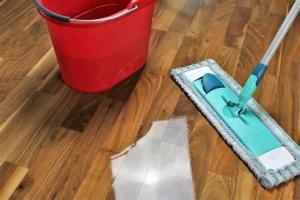Ultimate Guide on How to Effectively Clean Sticky Hardwood Floors

-
Quick Links:
- Introduction
- Understanding Sticky Hardwood Floors
- Why Do Hardwood Floors Get Sticky?
- Tools and Materials Needed
- Step-by-Step Cleaning Guide
- Preventative Measures for Sticky Floors
- Case Studies and Real-Life Examples
- Expert Insights and Tips
- FAQs
Introduction
Hardwood floors are a stunning addition to any home, providing warmth and elegance. However, they can also be prone to stickiness due to various factors. In this comprehensive guide, we will explore the reasons behind sticky hardwood floors, how to clean them effectively, and tips to prevent stickiness in the future. With expert insights and step-by-step instructions, you'll be well-equipped to maintain the beauty of your hardwood floors.
Understanding Sticky Hardwood Floors
Sticky hardwood floors can be frustrating and unsightly. This stickiness often results from a buildup of residue, dirt, or moisture that interferes with the natural finish of hardwood. Understanding the causes and how to address them is key to maintaining your floors.
Why Do Hardwood Floors Get Sticky?
Several factors can contribute to sticky hardwood floors:
- Improper Cleaning Products: Many commercial cleaning products can leave a sticky residue.
- Moisture: Excess moisture can lead to sticky surfaces.
- Wax Build-Up: Over-waxing can create a sticky layer on the surface.
- Food and Drink Spills: Sticky spills can create a residue if not cleaned promptly.
- Dust and Dirt: A buildup of dirt can trap moisture and create stickiness.
Tools and Materials Needed
Before you start cleaning, gather the following tools and materials:
- Microfiber mop
- Bucket
- Soft-bristle broom or vacuum cleaner
- White vinegar
- Dish soap
- Warm water
- Wood floor cleaner (optional)
- Dry towels
Step-by-Step Cleaning Guide
Follow these steps to effectively clean sticky hardwood floors:
Step 1: Sweep or Vacuum
Start by sweeping or vacuuming the floor to remove loose dirt and debris.
Step 2: Prepare the Cleaning Solution
Mix a solution of warm water with one cup of white vinegar and a few drops of dish soap in your bucket.
Step 3: Mop the Floor
Dip your microfiber mop into the cleaning solution, wringing it out so it’s damp but not soaking wet. Mop the floor in the direction of the wood grain.
Step 4: Rinse the Mop
Rinse the mop regularly in clean water to avoid reapplying dirt. Change the solution if it becomes too dirty.
Step 5: Dry the Floor
Use dry towels to wipe up any excess moisture and to prevent water damage.
Step 6: Treat Tough Spots
If any sticky spots remain, apply a small amount of the cleaning solution directly to the area and scrub gently with a soft cloth.
Preventative Measures for Sticky Floors
Preventing sticky hardwood floors can save you time and effort in the long run. Consider the following tips:
- Use a damp mop instead of a wet one.
- Choose cleaning products specifically designed for hardwood floors.
- Regularly dust and vacuum to reduce dirt accumulation.
- Address spills immediately to prevent stickiness.
- Consider applying a protective finish every few years.
Case Studies and Real-Life Examples
Here are a few real-life examples of how homeowners tackled sticky hardwood floors:
- Case Study 1: A family discovered that their sticky floors were due to a buildup of a popular all-purpose cleaner. After switching to a vinegar solution, their floors regained their shine.
- Case Study 2: After a major family gathering, a homeowner faced sticky floors from juice spills. Prompt cleaning with a homemade solution resolved the issue quickly.
Expert Insights and Tips
We consulted cleaning experts for their top tips:
- “Regular maintenance is key to preventing sticky floors. A weekly cleaning can make all the difference.” - Jane Smith, Cleaning Specialist
- “Always test new products on a small area to ensure they don't damage your finish.” - John Doe, Hardwood Flooring Expert
FAQs
1. What cleaning products can I use for sticky hardwood floors?
Use a mixture of vinegar and water, or a dedicated hardwood floor cleaner.
2. Can I use a steam mop on hardwood floors?
It's generally not recommended, as steam can damage the wood and finish.
3. How often should I clean my hardwood floors?
Weekly cleaning is ideal; however, high-traffic areas may require more frequent attention.
4. Are there any natural remedies for sticky floors?
Yes, a vinegar and water solution works well as a natural cleaner.
5. How do I remove wax build-up from hardwood floors?
Consider using a commercial wax remover or a mix of vinegar and water to clean the surface.
6. What should I do if my hardwood floors are still sticky after cleaning?
Reassess your cleaning method and solution, or consult a professional for persistent issues.
7. Is it safe to use bleach on hardwood floors?
No, bleach can damage the wood and finish and is not recommended for cleaning hardwood floors.
8. Can I use a regular mop to clean hardwood floors?
It's best to use a microfiber mop to avoid excess water and damage.
9. How can I prevent sticky floors from occurring?
Regular cleaning, immediate spill management, and using the right products can prevent stickiness.
10. Should I hire a professional cleaner for sticky floors?
If you’ve tried DIY methods without success, hiring a professional may be a good option.
Random Reads